As an Amazon Associate KitchenwareSets.com earns from qualifying purchases.
7 Stunning Japanese Kitchen Ideas for Small Spaces
Are you constantly battling for counter space in a kitchen that feels cramped and chaotic? It’s a frustratingly common problem in smaller homes, where every inch is precious real estate. The constant visual noise of appliances, utensils, and containers can make what should be a creative and joyful space feel stressful and disorganized, turning the simple act of cooking into a daily struggle.
This is where the timeless wisdom of Japanese design offers a breath of fresh air. We’ve distilled years of interior design research and principles of Japanese aesthetics into a simple, actionable guide for your home. Japanese kitchen design for small spaces focuses on minimalism, natural materials, and smart storage to create a serene, functional, and uncluttered environment. It uses light colors and clean lines to make the space feel larger and more open, transforming chaos into calm.
7 Stunning Japanese Kitchen Ideas to Transform Your Small Space
Ready to trade clutter for tranquility? This isn’t just about aesthetics; it’s about creating a kitchen that works smarter, not harder. Each of these seven ideas is a powerful step towards a more organized, beautiful, and peaceful cooking environment. Each of these ideas is curated from top interior design sources and adapted for real-world small kitchens, ensuring they are both beautiful and practical. Let’s explore how you can bring these principles into your home.
1. Embrace Minimalism and Decluttering for a Spacious Feel
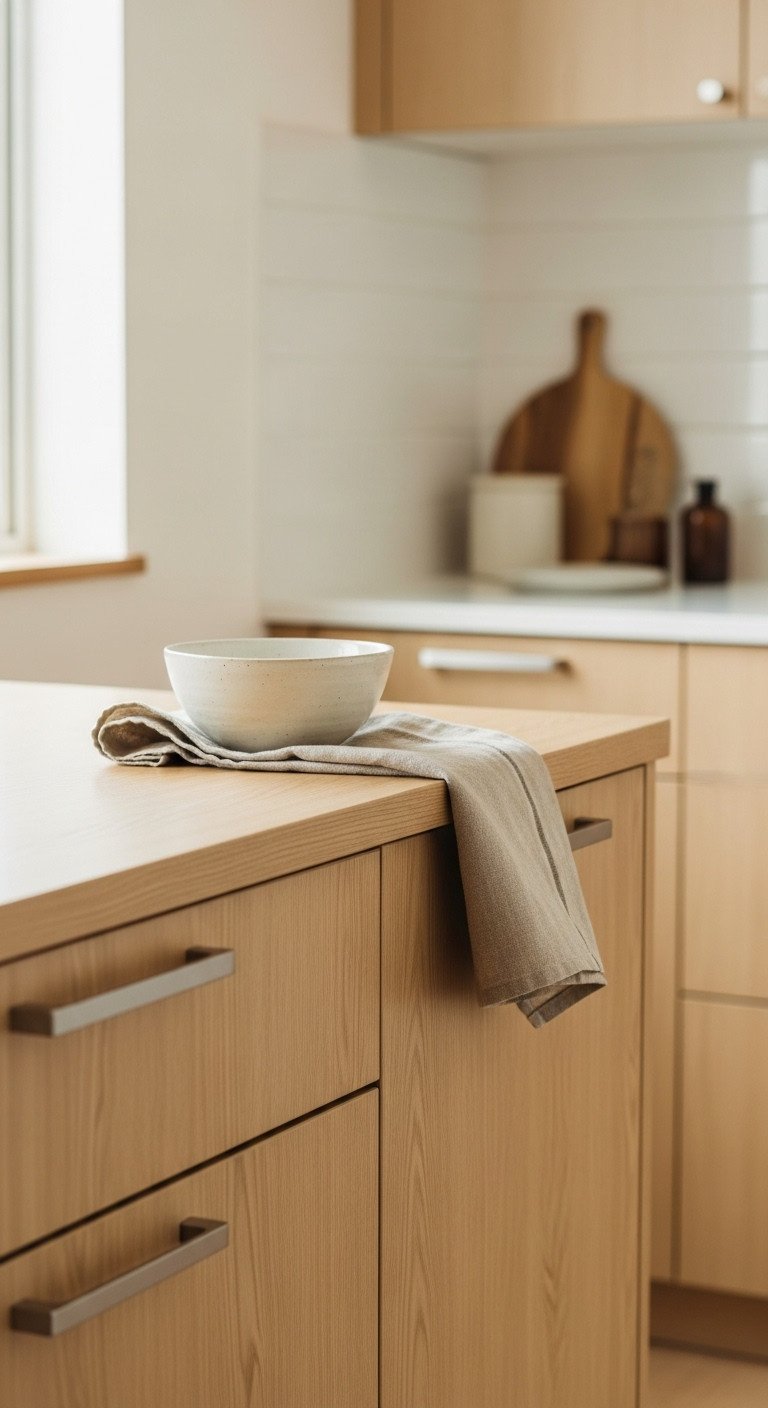
Save this idea to your ‘Minimalist Home’ board!
The foundational principle of Japanese kitchen design is clearing the clutter to create visual and mental space. This means being intentional about what you own and ensuring everything has a designated, hidden home.
- Materials Needed: Drawer dividers, cabinet organizers, clear containers, donation box.
- Step-by-Step Directions:
- Empty Everything: Start by completely emptying one cabinet or drawer at a time.
- Categorize & Purge: Sort items into three piles: keep, donate, and discard. Be ruthless with duplicates or unused gadgets.
- Designate a Home: Assign a specific, logical place for every item you keep.
- Organize Inside: Use high-quality bamboo drawer dividers to neatly arrange utensils. Employ stackable shelf organizers inside cabinets to maximize vertical space and prevent items from getting lost in the back.
- Maintain the Counter: Keep only 2-3 essential, beautiful items on the countertop (e.g., a knife block, a utensil crock). Store everything else away.
Pro-Tip: Adopt the “one in, one out” rule. For every new kitchen item you buy, commit to getting rid of one old item. This prevents clutter from building back up over time.
2. Use Natural Materials and a Neutral Color Palette
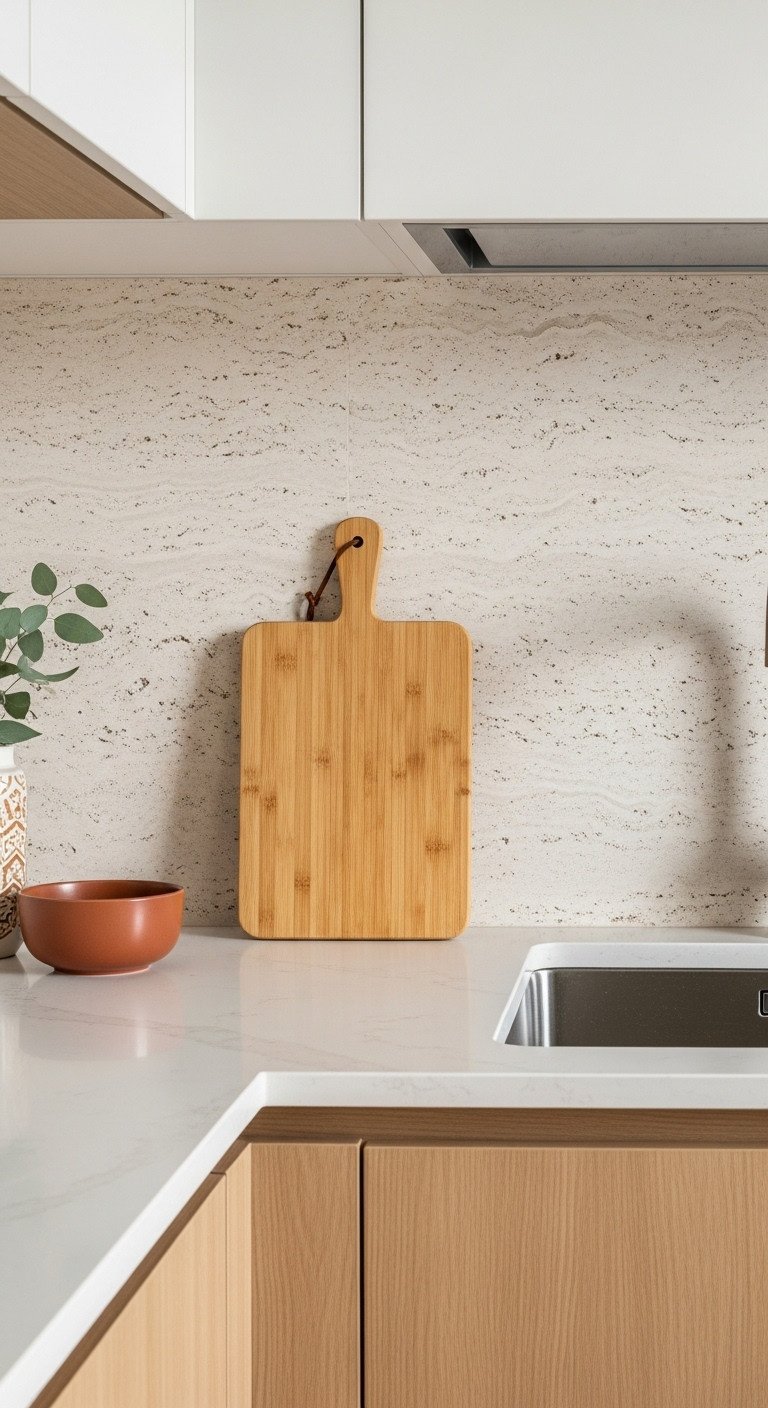
Save this texture inspiration to your ‘Japandi Kitchen’ board!
To create a warm and inviting space, Japanese design relies on a palette drawn from nature. Think light woods, textured stones, bamboo, and warm, muted colors like beige, cream, and off-white. This combination makes a small kitchen feel brighter and more open.
- Materials Needed: Paint swatches (beige, cream, off-white), material samples (light wood veneer, stone tile), peel-and-stick backsplash.
- Step-by-Step Directions:
- Start with the Palette: Choose a primary neutral color like warm white or beige for the walls to maximize light.
- Introduce Wood: Incorporate light-colored wood for cabinets, open shelves, or countertops. Oak, maple, and bamboo are excellent choices.
- Add Texture with Stone: Consider a backsplash made of natural stone or a high-quality stone-look tile. For a budget-friendly update, a textured beige peel-and-stick tile backsplash can create a similar organic feel without a full renovation.
- Accessorize Naturally: Use bamboo cutting boards, stone utensil holders, or woven rattan placemats to layer in more organic textures.
Lesson Learned: Always test paint colors in your actual kitchen light. A beige that looks perfect in the store can look yellow or gray depending on your natural and artificial lighting.
3. Optimize Space with Smart Layouts and Vertical Storage
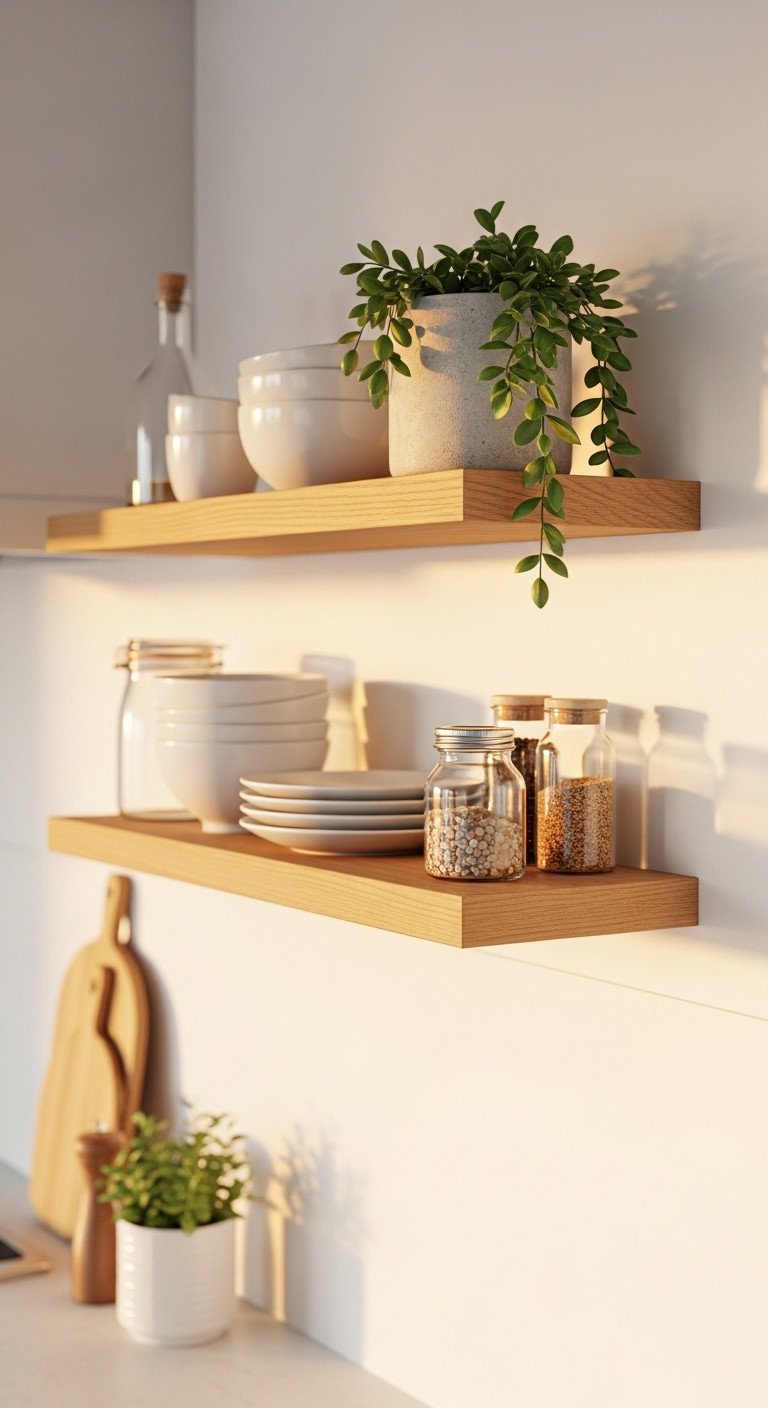
Pin this shelf styling idea for later!
In a small kitchen, the walls are your best friend. Using vertical storage like floating shelves draws the eye upward, creating an illusion of height and freeing up valuable counter space.
- Materials Needed: Floating shelves, stud finder, drill, level, wall anchors.
- Step-by-Step Directions:
- Identify Vertical Space: Look for an empty wall space above your counter, sink, or a small nook.
- Choose Your Shelves: Select simple, minimalist floating wood shelves that match the other wood tones in your kitchen. Ensure they are deep enough for plates but not so deep they feel obtrusive.
- Find the Studs: Use a stud finder to locate the wall studs for the most secure installation. This is crucial for shelves that will hold heavy dishes.
- Install Securely: Use a level to ensure the shelves are perfectly straight. Drill pilot holes and secure the shelf brackets directly into the studs. If a stud isn’t available, use heavy-duty wall anchors rated for the weight you plan to store.
- Style with Intention: Arrange your most frequently used (and most beautiful) dishes, glasses, and a small plant on the shelves. This keeps essentials within reach and adds a decorative element.
Pro-Tip: Before drilling, use painter’s tape to mark out the shelf placement on the wall. This allows you to step back and visualize the height and spacing to ensure you love the layout before making any holes.
4. Integrate Multi-functional Furniture and Compact Appliances
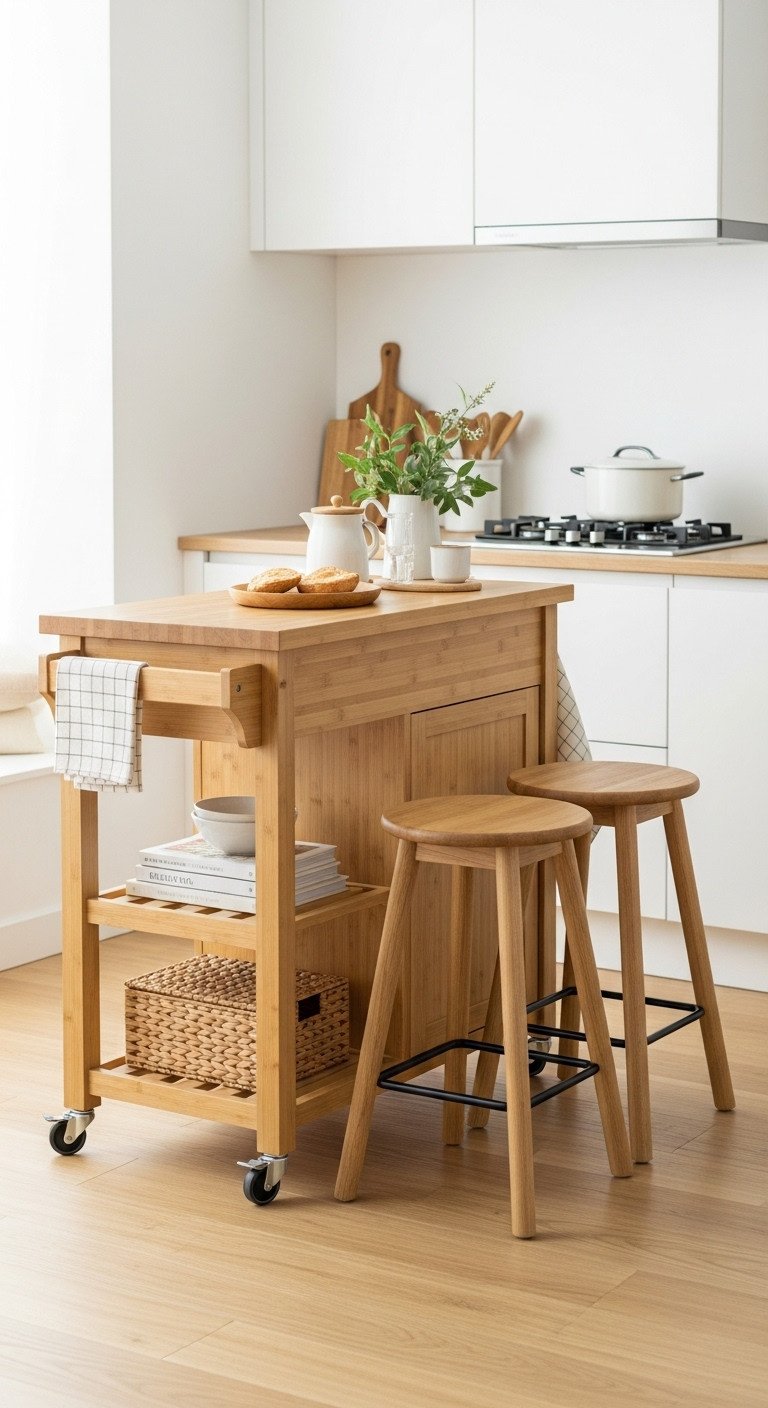
Love this flexible space idea? Save it to your ‘Small Kitchen Solutions’ board!
Every item in a small kitchen should earn its keep. Choose furniture and appliances that serve multiple purposes, such as a small kitchen cart that doubles as a prep station and a breakfast bar.
- Materials Needed: Measuring tape, chosen kitchen cart/island.
- Step-by-Step Directions:
- Measure Your Space: Before buying anything, carefully measure the available floor space. Remember to account for clearance to walk around and open cabinet doors.
- Prioritize Function: What do you need most? Extra counter space? A small dining spot? More storage? Look for a piece that solves your biggest problem.
- Find the Right Piece: Search for a small kitchen cart with a wood top. Features to look for include wheels for mobility, built-in shelves or drawers for storage, and an overhang on one side that allows stools to be tucked underneath for seating.
- Assemble and Position: Assemble the cart according to the manufacturer’s instructions. Position it in your kitchen to serve as a prep station, a coffee bar, or a small dining table as needed.
Pro-Tip: Look for a kitchen cart with locking wheels. This gives you the flexibility to move it easily for cleaning or rearranging, but ensures it stays securely in place when you’re using it for chopping or prep work.
5. Layer Lighting for Ambiance and Functionality
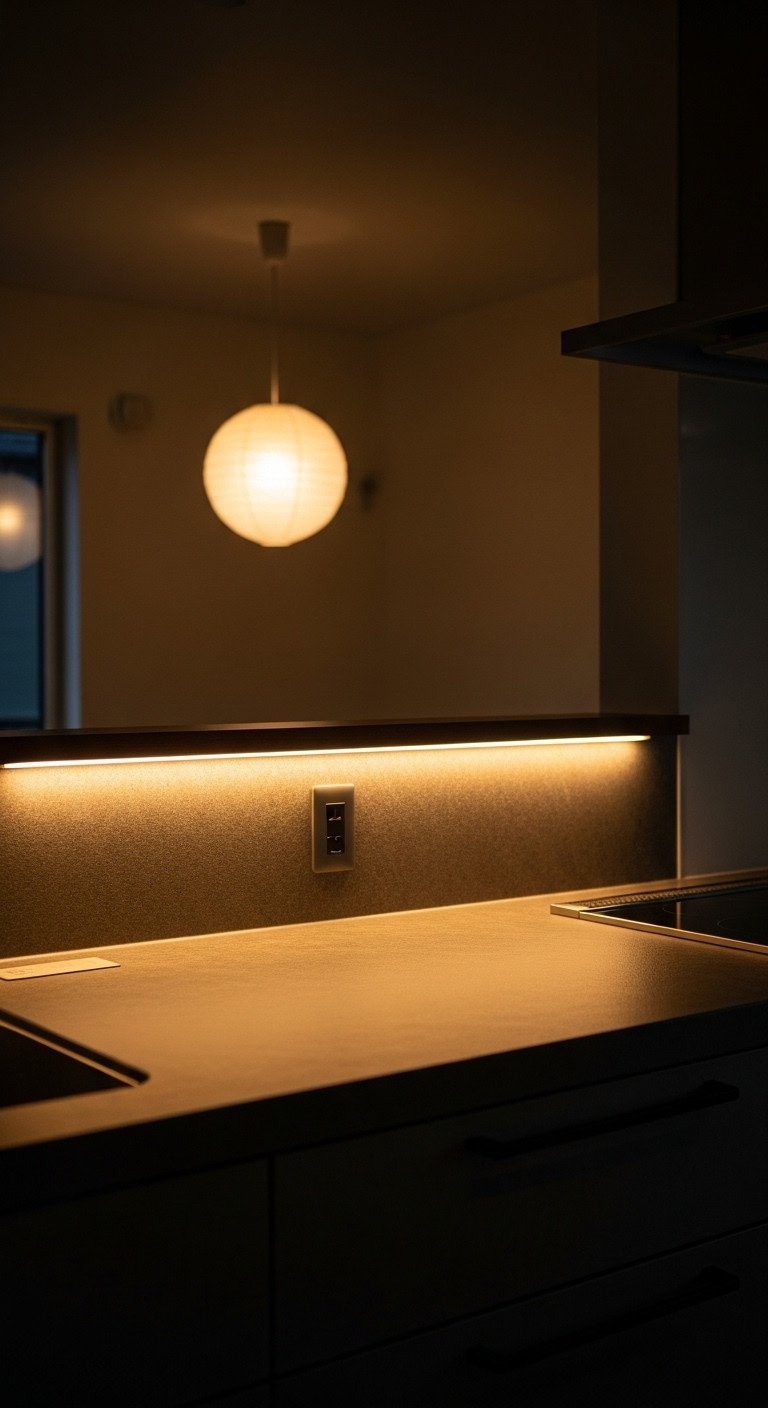
Save this cozy lighting idea to your ‘Home Ambiance’ board!
Good lighting is transformative. Layering different types of light—ambient, task, and accent—makes a kitchen functional for cooking and creates a warm, inviting atmosphere for relaxing.
- Materials Needed: LED under-cabinet lighting kit, measuring tape, cleaning cloth, adhesive clips.
- Step-by-Step Directions:
- Assess Your Needs: Identify the darkest areas of your kitchen. The most important place for task lighting is under the upper cabinets to illuminate your countertops.
- Choose the Right Kit: Opt for a plug-in or hardwired LED under cabinet lighting kit that emits a warm white light (around 2700K-3000K) for a cozy feel. Many kits come with adhesive backing for easy installation.
- Prep the Surface: Thoroughly clean the underside of your cabinets with rubbing alcohol to ensure the adhesive tape sticks properly.
- Install the Lights: Measure and cut the LED strip to size, if necessary. Peel off the backing and press the light strip firmly into place, hiding it behind the front lip of the cabinet.
- Manage Cords: Use the included clips to neatly secure any wires out of sight. Enjoy your brightly lit, functional workspace!
Lesson Learned: Always install a dimmer switch for your main overhead lights. This gives you maximum control, allowing for bright light when cooking and soft, ambient light for relaxing or entertaining.
6. Bring in Natural Elements and Greenery
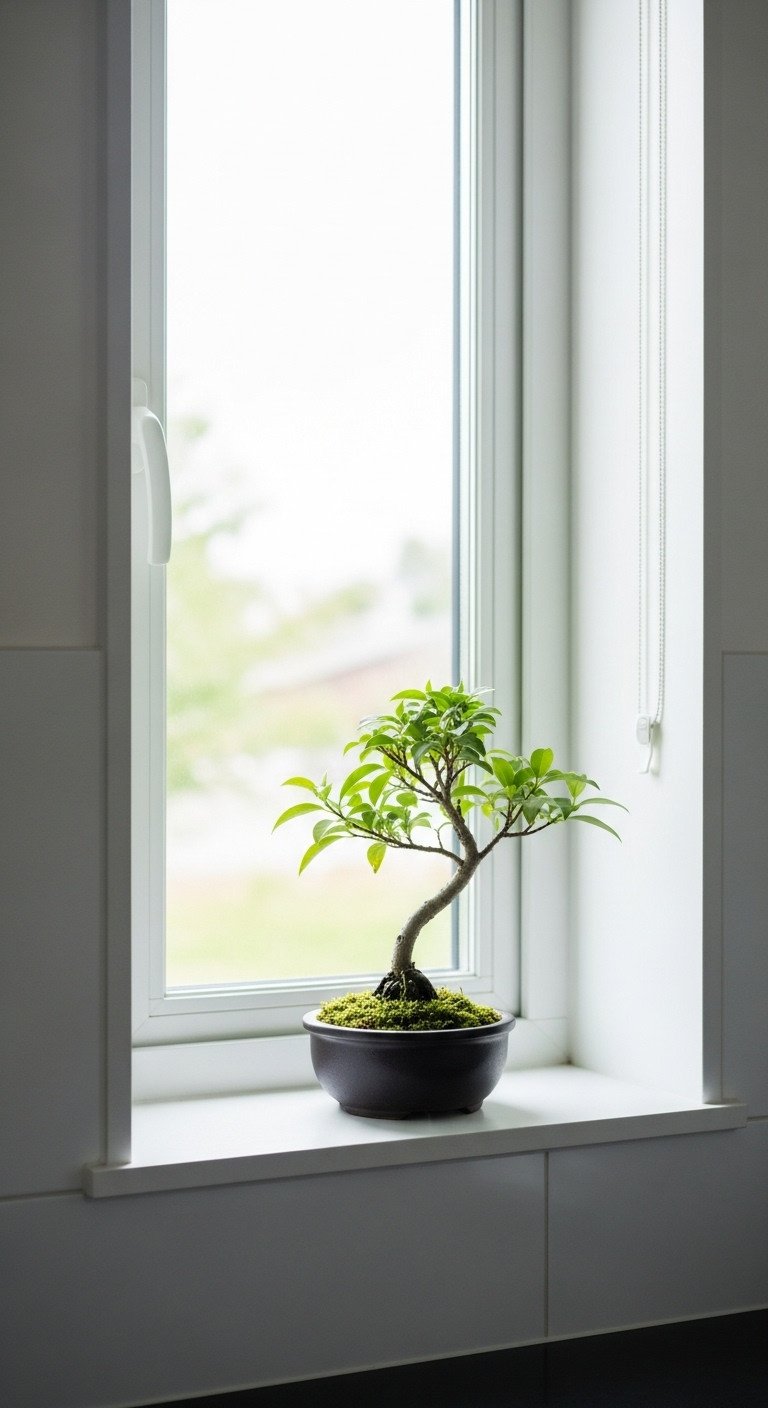
Pin this touch of Zen for your kitchen!
A connection to nature is central to Japanese aesthetics. Adding a small plant or a single branch brings life, color, and a sense of calm into your kitchen, creating a small moment of Zen.
- Materials Needed: Small plant (succulent, herb, or faux bonsai), minimalist ceramic pot, potting soil (if needed).
- Step-by-Step Directions:
- Assess Your Light: Determine how much natural light the spot you’ve chosen receives. This will dictate the type of plant that will thrive there.
- Select a Plant: For a low-maintenance option that captures the Japanese aesthetic, choose a simple succulent, a snake plant, or a high-quality faux plant. A small, realistic faux bonsai tree can provide the perfect sculptural element without the demanding care.
- Choose a Minimalist Pot: Find a simple pot made of natural materials like ceramic or terracotta in a neutral color (white, black, or gray). Ensure it has a drainage hole if you’re using a real plant.
- Pot and Place: Pot your plant and place it on a windowsill, an open shelf, or a corner of the counter where it can be enjoyed without creating clutter.
Pro-Tip: A small pot of fresh herbs like basil or mint is a perfect addition. It adds greenery, smells wonderful, and is functional for cooking—embodying the Japanese principle of beauty in utility.
7. Focus on Clean Lines and Intentional Decor
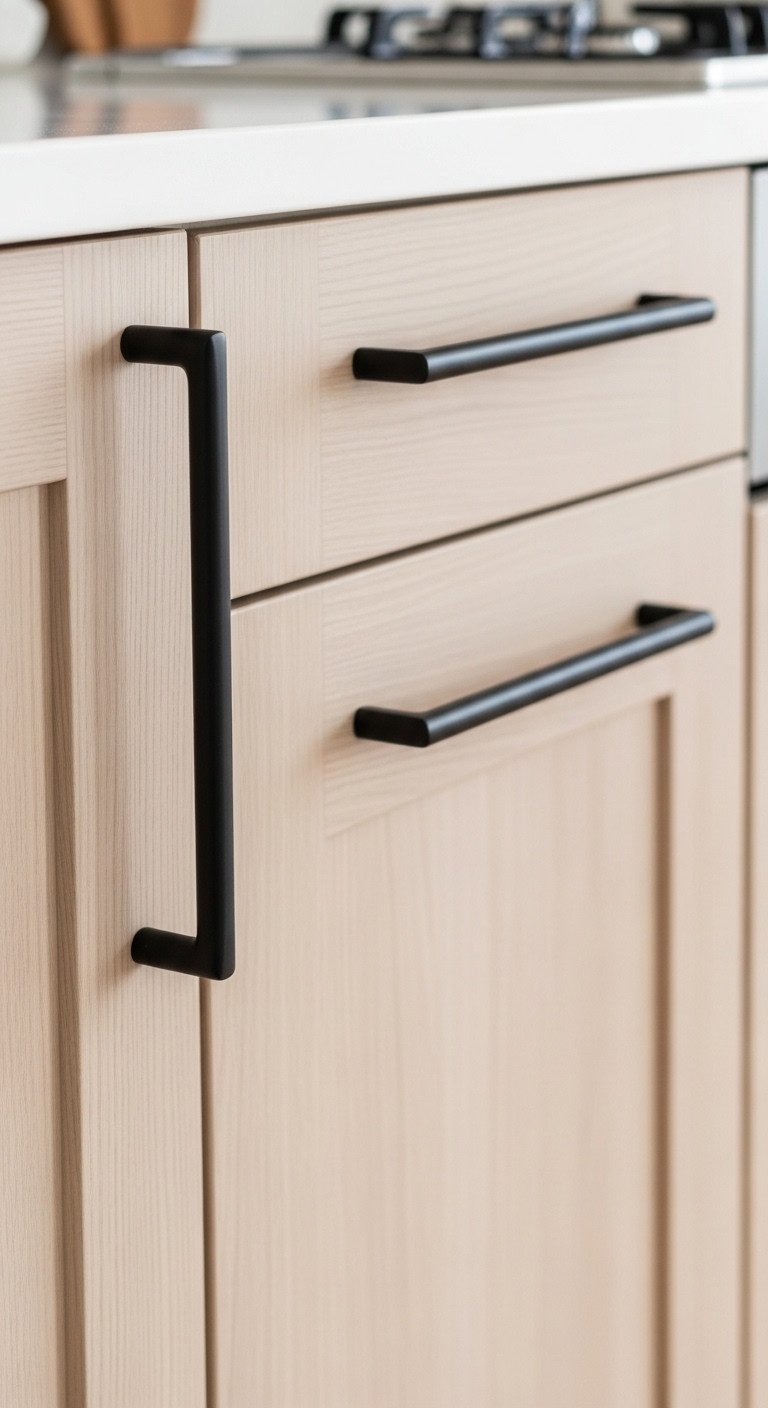
Save this hardware detail to your ‘Kitchen Finishes’ board!
The final touches matter immensely. Choose decor and hardware that reinforce the clean, uncluttered aesthetic. Think flat-panel cabinets, simple hardware, and textiles made of natural fibers.
- Materials Needed: New cabinet hardware, screwdriver, measuring tape, drill (if holes are new).
- Step-by-Step Directions:
- Assess Your Hardware: Look at your current cabinet knobs and pulls. If they are ornate or dated, swapping them is one of the easiest, most impactful updates.
- Measure Existing Holes: If you’re replacing existing hardware, measure the distance between the screw holes (center-to-center) to find new pulls that will fit without extra drilling.
- Select Minimalist Hardware: Choose hardware with clean, simple lines. Long, slim matte black cabinet handles or simple knobs in a brushed metal finish work beautifully in a Japanese-inspired kitchen. They provide a touch of modern contrast against light wood.
- Install the New Hardware: Unscrew the old hardware from the inside of the cabinet door or drawer. Screw the new hardware into place. Ensure all handles are level and aligned.
Pro-Tip: Decor should be both beautiful and useful. Choose a single piece of art, a beautiful ceramic utensil holder, or high-quality linen kitchen towels. Each item should earn its place in the space.
@juicedkitchens Japanese kitchen design inspo for ppl who hate sad beige kitchens bookmark if you want to buy this magazine book (Mook) Title: Casa Brutus Kitchen & Tools edition Release: Feb 2025 ISBN: 9784838754427 #kitchendesign #kitchenrenovation #kitchendesignideas #japanesekitchen #greenscreen
Key Takeaways: Your Quick Guide to Japanese Kitchen Ideas
- Embrace Minimalism: Less is more. Keep countertops clear and ensure every item has a home.
- Go Natural: Use light wood, stone, and bamboo with a warm, neutral color palette to create a serene feel.
- Think Vertically: Utilize open shelving and smart organizers to maximize storage and free up counter space.
- Choose Dual-Purpose Items: Opt for multi-functional furniture and compact appliances to make the most of limited square footage.
- Add Greenery: A single plant, like a bonsai or succulent, adds life and a touch of Zen.
People Also Ask About Japanese Kitchen Ideas
What is a Japanese style kitchen?
A Japanese style kitchen is characterized by minimalism, functionality, and a strong connection to nature. It features natural materials like wood and stone, a neutral color palette, clean lines, and uncluttered surfaces. The design prioritizes creating a calm, harmonious, and highly efficient space, even when small, blending traditional aesthetics with modern simplicity.
How to design a Japandi kitchen?
To design a Japandi kitchen, blend Japanese minimalism with Scandinavian functionality. Use natural materials like light woods and stone, and stick to a neutral color palette of white, beige, grey, and black. Focus on clean lines, handleless cabinets, and decluttered surfaces. Finish the space with simple, functional decor, cozy textiles, and a touch of greenery.
What is the difference between kitchen and daidokoro?
While both can mean “kitchen,” “daidokoro” (台所) is the more formal and common Japanese word for a home kitchen, the place where meals are prepared. The English word “kitchen” (キッチン) is also widely used in Japan, often referring to more modern, Western-style kitchen setups, especially in newer apartments and homes.
Final Thoughts
Creating a serene Japanese-inspired kitchen in a small space isn’t about expensive renovations; it’s about intentional choices. By focusing on minimalism, nature, and functionality, you can craft a beautiful kitchen that feels calm, spacious, and joyful to cook in. Which of these ideas are you most excited to try in your home? Let us know in the comments below
Last update on 2025-10-14 at 22:55 / Affiliate links / Images from Amazon Product Advertising API
